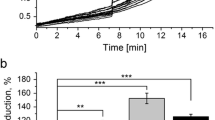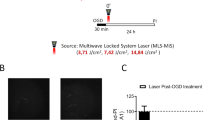Abstract
Laser irradiation-induced phototoxicity has been intensively applied in clinical photodynamic therapy for the treatment of a variety of tumors. However, the precise laser damage sites as well as the underlying mechanisms at the subcellular level are unknown. Using a mitochondrial fluorescent marker, MitoTracker Green, severe mitochondrial swelling was noted in laser-irradiated rat brain astrocytes. Nucleus condensation and fragmentation revealed by propidium iodide nucleic acid staining indicated that laser-irradiated cells died from apoptosis. Using an intracellular reactive oxygen species (ROS) fluorescent dye, 2′,7′-dichlorofluorescin diacetate, heterogeneous distribution of ROS inside astrocytes was observed after laser irradiation. The level of ROS in the mitochondrial compartment was found to be higher than in other parts of the cell. With another ROS fluorescent dye, dihydrorhodamine-123, and time-lapse laser scanning confocal microscopy, a substantial increase in mitochondrial ROS (mROS) was visualized in visible laser-irradiated astrocytes. The antioxidants melatonin and vitamin E largely attenuated laser irradiation-induced mROS formation and prevented apoptosis. Cyclosporin A (CsA), a mitochondrial permeability transition (MPT) blocker, did not prevent visible laser irradiation-induced mROS formation and apoptosis. In conclusion, mROS formation contributes significantly to visible laser irradiation-induced apoptosis via an MPT-independent pathway.
Similar content being viewed by others
References
Atlante A, Calissano P, Bobba A, Azzariti A, Marra E, Passarella S. Cytochrome c is released from mitochondria in a reactive oxygen species (ROS)-dependent fashion and can operate as a ROS scavenger and as a respiratory substrate in cerebellar neurons undergoing excitotoxic death. J Biol Chem 275:37159–37166;2000.
Backway KL, McCulloch EA, Chow S, Hedley DW. Relationships between the mitochondrial permeability transition and oxidative stress during ara-C toxicity. Cancer Res 57:2446–2451;1997.
Belzacq AS, Jacotot E, Vieira HL, Mistro D, Granville DJ, Xie Z, Reed JC, Kroemer G, Brenner C. Apoptosis induction by the photosensitizer verteporfin: Identification of mitochondrial adenine nucleotide translocator as a critical target. Cancer Res 61:1260–1264;2001.
Bernadi P. The permeability transition pore. Control points of a cyclosporin A-sensitive mitochondrial channel involved in cell death. Biochim Biophys Acta 1275:5–9;1996.
Bradley MO, Sharkey NA. Mutagenicity and toxicity of visible fluorescent light to cultured mammalian cells. Nature 266:724–726;1977.
Brunet CL, Gunby RH, Benson RSP, Hicjman JA, Watson AJM, Brady G. Commitment to cell death measured by loss of clonogenicity is separable from the appearance of apoptotic markers. Cell Death Differ 5:107–115;1998.
Cai J, Jones DP. Superoxide in apoptosis. Mitochondrial generation triggered by cytochrome c loss. J Biol Chem 273:11401–11404;1998.
Carter WO, Narayanan PK, Robinson JP. Intracellular hydrogen peroxide and superoxide anion detection in endothelial cells. J Leukoc Biol 55:253–258;1994.
Castro DJ, Saxton RE, Soudant J. The concept of laser phototherapy. Otolaryngol Clin North Am 29:1011–1029;1996.
Chakraborti T, Das S, Mondal M, Roychoudhury S, Chakraborti S. Oxidant, mitochondria and calcium: An overview. Cell Signal 11:77–85;1999.
Churchill ME, Peak JG, Peak MJ. Repair of near-visible and blue-light-induced DNA single-strand breaks by the CHO cell lines AA8 and EM9. Photochem Photobiol 54:639–644;1991.
Costantini P, Jacotot E, Decaudin D, Kroemer G. Mitochondrion as a novel target of anticancer chemotherapy. J Natl Cancer Inst 92:1042–1053;2000.
Cuzzocrea S, Riley DP, Caputi AP, Salvemini D. Antioxidant therapy: A new pharmacological approach in shock, inflammation, and ischemia/reperfusion injury. Pharmacol Rev 53:135–159;2001.
Du C, Fang M, Li Y, Li L, Wang X. Smac, a mitochondrial protein that promotes cytochrome c-dependent caspase activation by eliminating IAP inhibition. Cell 102:33–42;2000.
Emmendorffer A, Hecht M, Lohmann-Matthes ML, Roesler J. A fast and easy method to determine the production of reactive oxygen intermediates by human and murine phagocytes using dihydrorhodamine 123. J Immunol Methods 131:269–275;1990.
Fahimi HD, Baumgart E. Current cytochemical techniques for the investigation of peroxisomes: A review. J Histochem Cytochem 47:1219–1232;1999.
Friedmann H, Lubart R, Laulicht I. A possible explanation of laser-induced stimulation and damage of cell cultures. J Photochem Photobiol B 11:87–95;1991.
Heiskanen KM, Bhat MB, Wang HW, Ma J, Nieminen AL. Mitochondrial depolarization accompanies cytochrome c release during apoptosis in PC6 cells. J Biol Chem 274:5654–5658;1999.
Henry CA, Dyer B, Wagner M, Judy M, Matthews JL. Phototoxicity of argon laser irradiation on biofilms ofPorphyromonas andPrevotella species. J Photochem Photobiol B 34:123–128;1996.
Hockberger PE, Skimina TA, Centonze VE, Lavin C, Chu S, Dadras S, Reddy JK, White JG. Activation of flavin-containing oxidases underlies light-induced production of H2O2 in mammalian cells. Proc Natl Acad Sci USA 96:6255–6260;1999.
Johnson LV, Walsh ML, Chen LB. Localization of mitochondria in living cells with rhodamine 123. Proc Natl Acad Sci USA 77:990–994;1980.
Jones CA, Huberman E, Cunningham ML, Peak MJ. Mutagenesis and cytotoxicity in human epithelial cells by far- and near-ultraviolet radiations: Action spectra. Radiat Res 110:244–254;1987.
Jou MJ, Peng TI, Sheu SS. Histamine induces oscillations of mitochondrial free Ca2+ concentration in single cultured rat brain astrocytes. J Physiol 497:299–308;1996.
Jou TC, Jou MJ, Chen YY, Lee SY. Properties of rat brain astrocytes in long-term culture (in Chinese). Taiwan Yi Xue Hui Za Zhi 84:865–881;1985.
Kessel D, Castelli M. Evidence that bcl-2 is the target of three photosensitizers that induce a rapid apoptotic response. Photochem Photobiol 74:318–322;2001.
Kessel D, Luo Y. Photodynamic therapy: A mitochondrial inducer of apoptosis. Cell Death Differ 6:28–35;1999.
Kim CN, Wang XD, Huang Y, Ibrado AM, Liu L, Fang GF, Bhalla K. Overexpression of Bcl-X(L) inhibits Ara-C-induced mitochondrial loss of cytochrome c and other perturbations that activate the molecular cascade of apoptosis. Cancer Res 57:3115–3120;1997.
Kowaltowski AJ, Castilho RF, Vercesi AE. Mitochondrial permeability transition and oxidative stress. FEBS Lett 495:12–15;2001.
Kowaltowski AJ, Vercesi AE. Mitochondrial damage induced by conditions of oxidative stress. Free Radic Biol Med 26:463–471;1999.
Kroemer G. The proto-oncogene Bcl-2 and its role in regulating apoptosis. Nat Med 3:614–620;1997.
Kroemer G. Mitochondrial control of apoptosis: An overview. Biochem Soc Symp 66:1–15;1999.
LeBel CP, Ischiropoulos H, Bondy SC. Evaluation of the probe 2′,7′-dichlorofluorescin as an indicator of reactive oxygen species formation and oxidative stress. Chem Res Toxicol 5:227–231;1992.
Li LY, Luo X, Wang X. Endonuclease G is an apoptotic DNase when released from mitochondria. Nature 412:95–99;2001.
Marzo I, Brenner C, Zamzami N, Susin SA, Beutner G, Brdiczka D, Remy R, Xie ZH, Reed JC, Kroemer G. The permeability transition pore complex: A target for apoptosis regulation by caspases and bcl-2-related proteins. J Exp Med 187:1261–1271;1998.
Minamikawa T, Sriratana A, Williams DA, Bowser DN, Hill JS, Nagley P. Chloromethyl-X-rosamine (MitoTracker Red) photosensitizes mitochondria and induces apoptosis in intact human cells. J Cell Sci 112:2419–2430;1999.
Morgan J, Oseroff AR. Mitochondria-based photodynamic anti-cancer therapy. Adv Drug Deliv Rev 49:71–86;2001.
Paddock SW. Principles and practices of laser scanning confocal microscopy. Mol Biotechnol 16:127–149;2000.
Parshad R, Sanford KK, Taylor WG, Tarone RE, Jones GM, Baeck AE. Effect of intensity and wavelength of fluorescent light on chromosome damage in cultured mouse cells. Photochem Photobiol 29:971–975;1979.
Peng TI, Jou MJ, Sheu SS, Greenamyre JT. Visualization of NMDA receptor-induced mitochondrial calcium accumulation in striatal neurons. Exp Neurol 149:1–12;1998.
Poot M, Zhang YZ, Kramer JA, Wells KS, Jones LJ, Hanzel DK, Lugade AG, Singer VL, Haugland RP. Analysis of mitochondrial morphology and function with novel fixable fluorescent stains. J Histochem Cytochem 44:1363–1372;1996.
Popovic EA, Kaye AH, Hill JS. Photodynamic therapy of brain tumors. Semin Surg Oncol 11:335–345;1995.
Reiter R. Oxidative damage in the central nervous system: Protection by melatonin. Prog Neurobiol 56:359–384;1998.
Royall JA, Ischiropoulos H. Evaluation of 2′,7′-dichlorofluorescin and dihydrorhodamine 123 as fluorescent probes for intracellular H2O2 in cultured endothelial cells. Arch Biochem Biophys 302:348–355;1993.
Schuitmaker JJ, Baas P, van Leengoed HL, van der Meulen FW, Star WM, van Zandwijk N. Photodynamic therapy: A promising new modality for the treatment of cancer. J Photochem Photobiol B 34:3–12;1996.
Swanson J, Bushnell A, Silverstein S. Tubular lysosome morphology and distribution within macrophages depend on the integrity of cytoplasmic microtubules. Proc Natl Acad Sci USA 84:1921–1925;1987.
Thompson CB. Apoptosis in the pathogenesis and treatment of disease. Science 267:1456–1462;1995.
Tyrrell RM, Werfelli P, Moraes EC. Lethal action of ultraviolet and visible (blue-violet) radiations at defined wavelengths on human lymphoblastoid cells: Action spectra and interaction sites. Photochem Photobiol 39:183–189;1984.
Wang RJ. Lethal effect of ‘daylight’ fluorescent light on human cells in tissue-culture medium. Photochem Photobiol 21:373–375;1975.
Yang J, Liu X, Bhalla K, Kim CN, Ibrado AM, Cai J, Peng YI, Jones DP, Wang X. Prevention of apoptosis by Bcl-2:Release of cytochrome c from mitochondria blocked. Science 275:1129–1132;1997.
Zamzami N, Susin SA, Marchetti P, Hirsch T, Gomez-Monterrey I, Castedo M, Kroemer G. Mitochondrial control of nuclear apoptosis. J Exp Med 183:1533–1544;1996.
Zoratti M, Szabo I. The mitochondrial permeability transition. Biochim Biophys Acta 1241:139–176;1995.
Author information
Authors and Affiliations
Rights and permissions
About this article
Cite this article
Jou, MJ., Jou, SB., Chen, HM. et al. Critical role of mitochondrial reactive oxygen species formation in visible laser irradiation-induced apoptosis in rat brain astrocytes (RBA-1). J Biomed Sci 9, 507–516 (2002). https://doi.org/10.1007/BF02254977
Received:
Accepted:
Issue Date:
DOI: https://doi.org/10.1007/BF02254977




